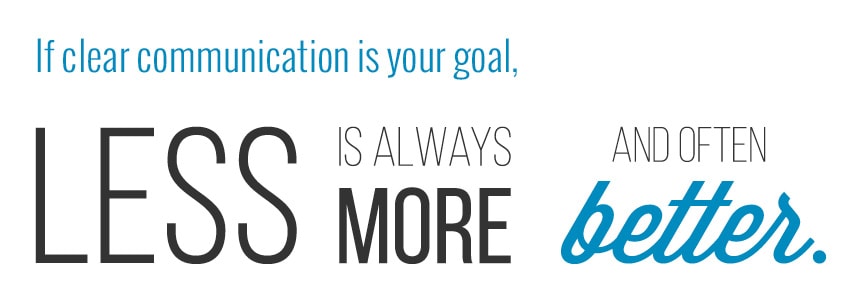Improve Communications with Five Less-Is-More Tips
Communication is the Lifeblood of Nearly Everything We Do
Whether your goal is to drive sales, educate or inspire, effective communication is at the heart of practically everything you do. If you must work with or through others to get something accomplished, you need effective communication. Speaking well is certainly important, but I want to share with you a few tips that can help you improve your effectiveness in written or visual communication. If you sometimes struggle to write letters, memos or other documents — even ad copy or web content — I think you will find these tips to be helpful.
1. Consider Your Audience … and Limit Your Message Accordingly
The words you may use to connect with 5th graders would be very different from those you might use to address peers in business. We would also communicate differently with entry level employees and the board of directors. A good first step toward improving your communications is to identify your audience. Once you understand clearly the audience you are trying to reach, you can omit communication that is not appropriate.
2. Use Fewer Words
Google provides the definition of brevity as follows:
We may have developed a bad habit of inflating our word count to meet a quota in high school. But brevity is critical for clear communication in business. Use fewer words that convey the same meaning whenever possible.
3. Use Clear Space to Bring Attention to Your Message
Before an orchestra begins, the conductor calls the musicians (and the audience) to silence. Think of words as sound and white space as visual silence. With sufficient silence, you create room for sound — your message. Margins are a simple way to add silence to your content. Another place we find clear space is within images: copy space. Many of the best magazine ads and billboards use images with copy space. Use the silence of clear space to provide a place for the message you intend to convey.
4. Use Clip Art Sparingly If at All
Clip art is rarely necessary. Not all clip art is bad, but some of it is downright awful. If you intend for your message to be light, informal and comedic, clip art may be justified. The problem is that a lot of people seem to use clip art habitually rather than intentionally. Think of the brevity principle. If your message stands alone without clip art, leave it out.
5. Know When to Call a Communications Professional
You may not be an art director or a marketing manager, but small businesses occasionally need the services of a copy writer or a layout artist. Think about the cost associated with a mistake. How many people would be affected? If business is on the line for a print ad, a billboard, or a press release, consider enlisting the services of a trusted professional.



